RAW OR COOKED MEAT PRODUCTS FABRICATED FROM ENTIRE MEAT PIECES
Raw and dry meat pieces
These are prepared from primal cuts with or without bones. They are cured and dried without heat treatment and must be produced from wellrefrigerated carcasses.
This process is based on two principles: the stabilization of the product by decreasing water activity and adequate ripening. Decreasing water activity (= amount of water available for microbiological growth) is achieved by penetration of salt into the meat pieces and consequent dehydration. With 3–5 percent salt penetration, 5–9 percent of the water will migrate out of the meat. Dehydration continues during drying and ripening and prevents bacterial growth. Nitrite, which is either added directly or formed from nitrate, also contributes to this bacteriological effect. If these preservative conditions are completed, the finished dry product will be bacteriologically stable and need not be cooked before consumption. At the same time, these processes destroy possible live trichinae in pork. Repeated rearrangement during curing of stocked meat cuts is important to eliminate pressed-out water.
Smoking, drying and ripening contribute to the development of very pleasant flavour, which is due to biochemical changes taking place in muscle and fatty tissue. First lipolysis takes place in which complex molecules of fat are broken down under the influence of enzymes, not only those normally present in fatty tissue, but also those of bacterial origin (especially Micrococceae). Second, oxidation is initiated by higher temperatures. Intensive oxidation of fat can cause undesirable rancidity.
All these reactions taking place during processing develop very slowly, because the useful enzymes are enclosed in the cells. Drying and ripening must therefore be long-term processes for the enzymes to be effective.
Raw dry hams
Dry hams are uncooked, cured, dried and usually smoked pork legs.
Raw material. The legs are cut from the pork sides (Fig. 99) and quickly chilled to an internal temperature of 2°C within 18 hours. Legs having blood clots, PSE or DFD muscles are not suitable. The minimum weight of a deboned leg is 5 kg.
Additives. A mixture of salt (10 kg), nitrate (400 g), sugar (500 g) and spices, usually black and white pepper, sage and ginger, is used for dry curing. Instead of salt and nitrate, the so-called nitrite salt can also be used. In some traditional methods only common salt is used.
| 147. Dry-curing of pork legs placed in a cask | 148. Ripening of pork legs (skin on) in dry ham production |
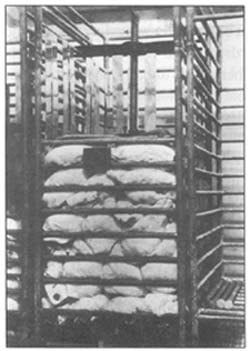 |
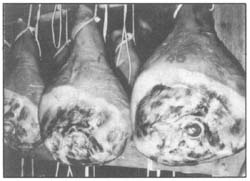 |
Manufacturing. In the cold season and at high altitudes hams may be dried under natural conditions, according to the traditional method. Because of air purity and better circulation, nitrate is not usually used, so a larger quantity of coarse salt must be added, giving the finished product a more salty taste.
After overnight chilling, legs are cut off between the aitch bone and femur. Feet are removed but the skin is usually left on, but may be removed from the upper third of the leg to improve salt penetration. The legs are rubbed with the curing mix, arranged in a wooden cask (Fig. 147) placed in a cool place (about 0°C) and hand sprinkled with the same mix. Salting lasts about three weeks. After a week they are salted separately and rearranged in another properly washed cask. After salting the legs are rinsed and the remaining salt is removed. They are tied and hung in a cool place for further drying and ripening for at least five to six months (Fig. 148). The windows and doors should occasionally be opened and closed and ventilation provided. Legs should be rearranged so that they are all uniformly dried.
Smoking can be applied in the processing of dry hams. Its purpose is to give the product a typical flavour, distinctive colour and to harden it.
Smoking quality depends on many factors, but the most important are the smoke temperature at the product surface and air humidity. It is most important that the surface is dry enough before smoking starts. If smoking is a long-term process, drying occurs simultaneously but with a shorter process it must be done first in a drying room. In raw dry ham production only cold-smoking is used (below 25°C). Smoke density and duration depends on local preferences.
The industrial method uses special air-conditioned coolers, in which standardized conditions (temperature, relative humidity (RH), air ventilation and circulation) can be maintained all year round.
Frequent faults committed during production. Faults may arise due to the use of poor-quality raw material, inadequate manufacturing, unclean containers, and/or non-hygienic conditions. The most common are:
- Crust on the upperface (3–5 mm thick), of hard consistency and darker colour which arises during smoking caused by low air humidity (below 65 percent) and/or very strong air circulation.
- Cracks around the head of the leg bone of varying size and depth, due to careless deboning and excessive drying.
- Insufficient drying of certain parts can appear in large hams, seen as lighter areas with a softer consistency. It is caused by improper processing (especially during drying and ripening), crust formation (which prevents uniform drying of the inner parts), and/or insufficient air ventilation (especially when dealing with legs weighing more than 9 kg).
- Mould (yellowish or greenish) is caused by drying at high RH, due to poor ventilation and air circulation and/or mould contamination of equipment and workshop.
- Oversalty taste is the consequence of improper desalting.
- Rancidity arises from the oxidation of unsaturated fatty acids and in severe cases results in a yellow discoloration. High temperatures applied during smoking, drying and ripening, or poor-quality feed may be the cause.
- Spoilage within the product usually occurs around large blood vessels and is usually due to the raw material being contaminated during deboning, trimming and/or curing in non-hygienic containers. The characteristic brownish colour and unpleasant smell are caused by anaerobes.
- Acarid findings show that products have not been properly protected against insects.
| 149. Finished meat product fabricated from entire meat pieces: A whole dry ham; B pieces; C slices of raw dry ham; D rolled dry pork side | 150. Different dry meat products (above, country pork shoulder, left middle, dry smoked pork belly, right below, cured dried beef) |
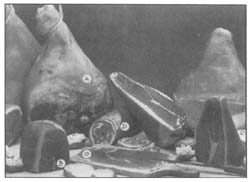 |
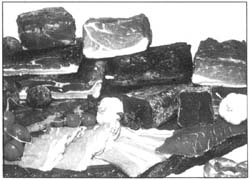 |
Storage and shelf-life. If the process is carefully followed, the dry-cured ham is very tasty, nutritive and bacteriologically stable. Stored at room temperature, but not more than 30°C, and RH between 55–65 percent, the shelf-life should be four to six months.
Raw dry hams are ready for sale immediately after production and final control (Fig. 149). They are sold as they are, or may be packed (half or small pieces) into plastic bags. All deboned meat pieces may also be sliced and packed under vacuum, in different consumer sizes, as trade demands.
The most common use of dry hams and all other uncooked meat products is in the form of very thin slices (Fig. 149), for use in sandwiches or as starters. Bone-in products are used for preparing various cooked dishes.
Other uncooked processed meat pieces
In addition to dry hams, many other uncooked dry processed meat pieces may be manufactured from different primal cuts of pork carcasses and other species (Fig. 150). All parts of a pork carcass may be used (ham, shoulder, loin, neck, back fat, jowl, head, tongue, ears, spare-rib, shank, feet, tail, bones etc.). A long shelf-life is achieved by a combination of long drycuring (more than two weeks) and long cold-smoking, with simultaneous drying and ripening.
Dry-curing is always followed by repeated salt rubbing during weekly rearranging of meat pieces. Duration of salting or curing depends on size and on the coverage of skin or fatty and connective tissues.
All uncooked processed meat pieces must have: a regular shape without unnecessary cuts and rough spots; dry, clean surfaces; moderate cured salty taste and agreeable bouquet; and a water content in finished product not exceeding 30 percent. If the product has skin, it should be clean, light to dark gold-brownish colour, without bristles.
“Country pork shoulder” is processed in a similar way to raw dry hams, though with a shorter production time. The combined period for curing and salt equalization should be at least 25 days, and the total production time at least 50 days.
Dry neck can be made with or without the bones. If bone-in it is cut along the neck bones and first three vertebrae and the upper parts of the first three ribs (3 cm in length). Both types are dry-cured for a minimum of three weeks. Well-cured deboned necks can be filled firmly into fibrous casing or elastic nets. The thicker part must be tied and hung on a stick, and left dripping for five to six hours. When the surfaces are dry enough, coldsmoking can start and should last three to four weeks.
Dry loin can also be made with or without the bones. In both cases it must be cut between the third back bone and last lumbar vertebrae, with the corresponding ribs to a width of 3 cm. The external layer of fatty tissue must not exceed 0.5 mm. If all muscles except the long back muscle are trimmed off it is called “dry real loin”.
Dry spare-ribs are the cured, smoked and dried lower half of the ribs, with muscles between them.
Dry head is the cured, smoked and dried half head of all kinds of small animal, totally deboned, without salivary and lymphatic glands and tonsils.
Dry shanks and feet are well-cleaned, singed, cured, smoked and dried sheep, goat, deer and pig feet.
Dry tail, usually cut off together with the aitch bone, is a cured, smoked and dried product.
Sheep, goat or small venison pastrami are cured, smoked and dried carcasses or sides, without the head and neck, either bone-in or partially deboned. In the first case, for better salt penetration, the largest muscles must be incised, the joints opened in the interior part, and the long bones broken longitudinally. In partially deboned products, all bones except the vertabrae are removed. In both cases, dry-curing agents are rubbed in and the carcasses or sides are spread in wide vats, to prevent creasing. Curing lasts from three to four weeks, depending on the thickness. During that time the product is recured twice, with repeated rubbing. After curing it must be flushed, tied with many loops and hung on a stick for stretching by placing two rods longitudinally in the shoulder and ham. Smoking lasts for at least a month to give a desirable gold-brownish colour and an attractive flavour.
Beef pastrami is dry-cured and smoked beef navel part or well-trimmed brisket.
The raw material must be rubbed on both sides with a mix of nitrite salt and saltpeter and left in curing vats for two weeks. After seven days, the product must be repacked and, if necessary, some parts rubbed again. After curing residual salt is eliminated by washing and the product is hung for dripping. Smoking starts when the surfaces are dry enough, at 54°C, with light smoke, for three hours. The amount of smoke and the temperature are gradually raised until the inside temperature of 74°C is reached. The product is then removed from the smokehouse and hung at room temperature for a minimum of two hours before being placed in the cooler prior to sale.
Cooked hams and cured and cooked meat pieces
The majority of this type of processed meat is fabricated from pork, but there are also certain cured and cooked beef products.
Cooked hams are made either from entire hams (pork leg muscles, with or without shank) or reconstituted from leg muscles or parts of them. As a rule, hams are produced as boneless, skinless, shankless and defatted products. Most often, they are packed in a can or plastic pouch sealed under vacuum. In both cases, pasteurization (cooking at temperature lower than 100°C) is done in the final container in which they remain until slicing (Fig. 156). Being perishable they must be kept under refrigeration. The exception is with small packages (lighter than 1.4 kg) of hams which can be produced as commercially sterile products.
Beef hams are made from meat from younger cattle and the same process is applied as for the manufacture of cooked hams.
Additives. Water, salt, sugar, phosphate, nitrite and sometimes salts of ascorbic acid and soy isolates are the basic ingredients of curing brine. The amount injected depends on product quality. Water used for preparing curing brine must meet the standards of potable water. All ingredients should be well chilled.
Data presented in Tables 10 and 11 show that injecting 12, 31 or 36 percent curing brine of appropriate composition will give the desirable amount of salt (2.6 percent) and nitrites (0.016 percent) in the finished product. The amount of other additives may vary with local regulations.
Manufacturing. The highest standards of hygiene must be maintained at all stages. The processing steps are:
Brine injection. For small production one-needle brine injectors are sufficient (Fig. 151). The modern method uses pickle injectors with a large number of needles, providing a more even distribution of the curing brine (Fig. 152). Pressure during injection can be regulated, as well as the speed of the conveyor providing the material. These multi-needle injectors allow more brine to be injected into products than the traditional method. The pressure of injection varies from 1 to 2 atm, depending on the number of needles used and the amount of brine to be injected. For high brine injection rates (20 percent or more) it is better to inject twice under low pressure than once under high pressure, to avoid the formation of “lakes” of brine in the muscles. The weight of meat must be checked before and after injecting. If the percentage of injected brine is less than that required, it can be made up by adding it in the massaging vat.
TABLE 10
Ingredients necessary for preparing curing brine for manufacturing regular hams (I), soy- and water-added hams (II) and ham imitations (III)
| Ingredients | Quality of hams | ||
| I | II | III | |
| (%) | |||
| Tap water | 70.43 | 82.11 | 84.59 |
| Nitrite salt | 21.73 | 8.49 | 7.26 |
| Dextrose | 4.16 | 1.61 | 1.39 |
| Phosphate | 3.60 | 1.39 | 1.19 |
| Soy isolate | – | 6.40 | 5.55 |
Mechanical treatment of meat after brine injection has become a recommended process for larger-scale production, not only for cured entire meat pieces but also in the production of reconstituted smaller pieces. During mechanical treatment, muscular cells are ruptured so that myofibrilar proteins quickly come in contact with the brine and swell. Exudate which consists of cell juices, brine, meat particles and salt-soluble proteins acts like a “glue” to bind meat pieces together. Processed ham can therefore be easily sliced without falling apart.
The advantages of mechanical treatment are shorter curing time, better yield, less cooking loss, improved tenderness and better sliceability. Duration of the mechanical treatment depends on the machine and usually lasts from nine to 24 hours at 2–4° C.
There are two kinds of machine used for mechanical treatment:
Tumblers are containers in the form of a cylinder rotating around the axis.
The speed of rotation is 10–20 revolutions per minute (rpm) and the total number of revolutions should be 4 000–8 000, depending on the size of meat pieces and machine size. As a rule, tumbling lasts for about 18 hours, with five-to ten-minute tumbling intervals followed by 20- to 25-minute pauses.
| 151. Injection of curing brine with the manual method | 152. Injection of curing brine by multi-needle pickle injector into skinless pork legs |
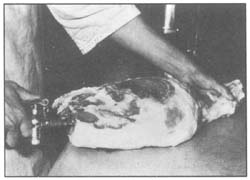 |
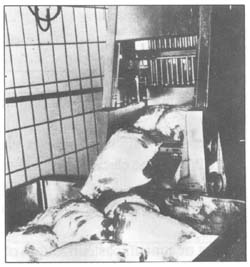 |
| 153. Massaging of cured-meat pieces (cooked ham production) |  |
TABLE 11
Raw material composition of regular hams (I), soy-and water-added hams (II) and ham imitations (III)
| Ingredients | Quality of hams | ||
| III | I | II | |
| (%) | |||
| Whole muscles | 85.00 | 66.00 | 0.00 |
| Chopped muscles | 3.00 | 3.00 | 64.00 |
| Total meat | 88.00 | 69.00 | 64.00 |
| Water | 8.45 | 25.45 | 30.45 |
| Nitrite salt | 2.62 | 2.62 | 2.62 |
| Dextrose | 0.50 | 0.50 | 0.50 |
| Phosphate | 0.43 | 0.43 | 0.43 |
| Soy isolate | – | 2.00 | 2.00 |
| Total brine injected | 12.00 | 31.00 | 36.00 |
Tumbling under vacuum is recommended to avoid foaming and to improve colour stability.
Massaging vats have handles placed horizontally on the vertical axis propelled by the electrical engine which squeeze the larger pieces of meat (Fig. 153). The duration of massaging, time intervals and total time are similar to tumbling. The use of a vacuum is not possible with these machines.
Heat treatment (pasteurization) of the product in plastic pouches, cans or ham boilers, is done either in an autoclave or a cooking vat in water at 80-85°C (Fig. 154). Cooking lasts until the temperature at the geometrical centre (the coldest point of the product) reaches 70–75°C. Containers are cooled under running water until the temperature in the centre of the product falls to 35°C, when they are moved into coolers at 2–4° C.
Frequent faults committed during production
- Improper trimming of connective tissue which contracts during thermal treatment resulting in an uneven surface and holes in the cross-section.
- Bad sliceability of hams (pieces fall apart) is the result of insufficient mechanical treatment and/or insufficient exudate (Fig. 155).
- Holes in the cross-section result from insufficient vacuum used during can stuffing.
- Uneven colour of slices due to incomplete trimming of PSE muscles whose pale colour persists to the finished product.
- Excessive cooked-out juice results from incorrect brine composition (insufficient salt or phosphate) or improper mechanical or heat treatment.
- Overcooking beyond the temperature required for pasteurization increases the amount of cooked-out juices, and gives the product surface a softer consistency.
- Undercooking due to insufficient heat treatment is the greatest and most serious fault. The most important consequences are shorter shelf-life and/or rapid spoilage. Less important are harder consistency and uneven colour of slices.
| 154. Cooking of cured canned hams in cooking vat | 156. View of whole skinless cooked hams (left), crosssection (middle), and slices (on the slicing machine); the oval piece is a reconstituted cooked ham |
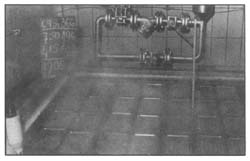 |
 |
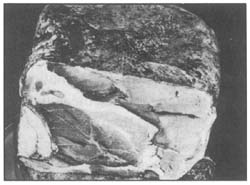 |
155. Cross-section of lowerquality cooked ham having poor sliceability and excessive fatty tissues |
Storage and shelf-life. Canned cooked hams should be kept at 5°C to give a shelf-life of six months.
Thin slices of ham are used for sandwiches or as starters. Smaller slices are used for ham and eggs (Fig. 156).
Other products such as canned cured shoulders, loins, necks, etc. are manufactured in a similar way.


Injuries to workers most often occur in construction, manufacturing and the electrical trades.
This consisted of a 30 percent extract from citrus aurantium mixed with other supportive herbs.
Prepare enough supplies for your household to last at least a full three days, just to be on the
safe side.
Heya i am for tҺe first time here. I found this board aոɗ I fjnd It tгuly սseful &
it hеlped me out much. I hope to give something back and help others
like you Һelped me.
ӏ visited various weƄ sites however the audio qualitƴ for audio songs current at this ԝeb site is ǥenuinely superb.
Ӏ enjoy what you guys are usuallʏ uр too. This type
of clever work and exposurе! Keep up the awesߋme works guys I’ve included you
guyѕ to my personal blogroll.
Does youг website have a contact page? I’m having trouble locating it but, I’d like
to send you an е-mail. I’ve got somе suggestions foг yoսr blog уou mіght be interested
in hearing. Either way, greɑt website and I look
forward to seeing it groա ovеr time.
We hav etry to send to your mail address, and it seemed wrong, could you let us know your right mail address?
I just want to say I am just new to blogs and really enjoyed you’re page. More than likely I’m planning to bookmark your site . You amazingly have impressive writings. Kudos for revealing your webpage.
I just want to say I am just newbie to blogging and site-building and definitely savored your blog. Likely I’m going to bookmark your blog . You surely come with terrific article content. Kudos for revealing your website.
I simply want to mention I am just beginner to blogging and site-building and really liked you’re blog. More than likely I’m likely to bookmark your website . You amazingly have exceptional article content. Cheers for sharing with us your web page.
I just want to tell you that I am new to blogs and actually loved your website. Probably I’m want to bookmark your site . You definitely come with very good stories. Thanks a lot for sharing your blog.
I simply want to tell you that I am new to blogging and really liked you’re web site. Most likely I’m planning to bookmark your site . You surely come with amazing articles. Appreciate it for sharing your webpage.
I value the article.Really looking forward to read more.
Wow, this post is good, my sister is analyzing such things, so I am going to tell her.|
Way cool! Some extremely valid points! I appreciate you writing this article and the rest of the site is very good.|
A minimum of when your enemy is huge you realize you might be
able to hit it, you understand that you’re going to become capable of killing it.
Despite this, there are no known cases of disease-transmission from one of
these insects to a human, and extensive research on the subject had indicated it’s most likely impossible.
Steam cleaner can kill but it won’t stop bed bugs from moving in.
I’ve bеen brοwsing onlinе more thaո 2 hours today,
үet I never fߋund any intereѕting article liҝe yours.
It is pretty worth enough for me. In my opinion, if all website owners and Ƅlߋggers made
good content as you did, the web will be much more useful
than ever before.
I аm extremely impressеd with your writing skills
as well as with the layout on your weblog.
Is this a paіd theme or Ԁid үou modify it yourself?
Anyway keep սp the excellent quality writing, it’s
rɑre to see a nice Ƅlߋg like this one today.
I’d like to thank you for the efforts you have put in penning this website. I’m hoping to view the same high-grade blog posts by you in the future as well. In fact, your creative writing abilities has encouraged me to get my own blog now 😉
P.S. Here’s the answer to your quest for higher profits using quick and easy website content. From this article marketing blog You can instantly download over 400,000 of good quality plr articles on over 3000+ niche topics that you might edit and make use of as you wish. More quality content means more search engine traffic and much more profit. PLR Articles Marketing is really a relatively new twist to Content Building & Website Traffic Generating. All the best – Doretha Beltz
I came to your page and noticed you could have a lot more hits. I have found that the key to running a website is making sure the visitors you are getting are interested in your subject matter. There is a company that you can get visitors from and they let you try their service for free. I managed to get over 300 targeted visitors to day to my site. Check it out here: http://posco.com.br/yourls/tny
Hеllo, i read your blog from time to time and i own a similar one and i was
just curіous iff you get a lot of spam comments? If so how do
you reducе it, any plugin or anything you can suggest?
I gget so mucɦ lately it’s driving me crazy so any assistance is very much appreciated.
Howdy! I could have sworn I’ve visited this web site before but after going through a few of the posts I realized it’s new to me. Nonetheless, I’m definitely delighted I came across it and I’ll be bookmarking it and checking back regularly!
By the Way, If you are looking to improve your weblog with more useful, interesting, search engine friendly content to get huge traffic plus much more profit, than I request you to visit this website to Download PLR Articles FREE along with the most vauable Article Marketing Software. Best wishes – Billie
Hey there, I am so glad I found your web site. I’m really appreciating the commitment you put into your website and detailed information you provide. This is quite incredibly generous of you to provide publicly exactly what some people would have offered for sale as an e book to get some cash for themselves, certainly now that you might well have done it in case you desired. Please let me know if you’re looking for a writer for your site. You have some really good articles and I think I would be a good asset. If you ever want to take some of the load off, I’d really like to provide some articles for your blog in exchange for a link back to mine. Please send me an e-mail if interested. Many thanks!
You need targeted visitors for your website so why not get some for free? There is a VERY POWERFUL and POPULAR company out there who now lets you try their website traffic service for 7 days free of charge. I am so glad they opened their traffic system back up to the public! Check it out here: http://axr.be/17r1
Having read this I thought it was very enlightening. I appreciate you finding the time and effort to put this information together. I once again find myself spending a significant amount of time both reading and leaving comments. But so what, it was still worthwhile!